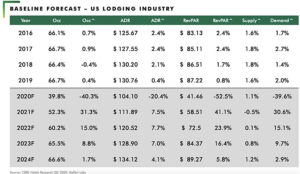As H&LA keeps abreast the continually changing impact of COVID-19 on the economy in general and hospitality sector in particular, we are sharing insights from industry experts and stakeholders with our clients and partners. Recent CBRE projections indicate that the U.S. hotel industry is poised to begin a multiyear recovery in the third quarter.
Published by: Hotel Business
Published date: September 2020
After facing the lowest occupancy levels since the 1930s and the greatest declines in revenues and profits ever experienced in the second quarter, the U.S. hotel industry is poised to begin a multiyear recovery in the third quarter.
According to Kalibri Labs, the number of room nights occupied in U.S. hotels during the second quarter was 60% less than a year earlier. With such a dramatic decline in demand, the national occupancy level for the quarter was just 28.3%. It is estimated that 15% of U.S. hotels were forced to close for some portion of the three-month period.

“Fortunately for U.S. hoteliers, indicators of market recovery began to emerge during the quarter,” said Jamie Lane, senior director, CBRE Hotels Research. “After bottoming out in April, lodging demand increased 83% in May and June. This mini surge in demand was fueled by leisure travelers looking to escape the bonds of home quarantine for safe and healthy rural and resort destinations.”
Beyond last quarter’s nadir, CBRE Hotels Research is forecasting continued improvement in U.S. lodging performance through the remainder of the year and beyond. According to the Q2 2020 edition of Hotel Horizons, U.S. hotel occupancy should average 39.8%, along with an ADR of $104.10 for 2020. The net result is an annual RevPAR level of $41.46, which is 52.5% less than the $87.22 RevPAR posted for 2019.
“U.S. lodging demand is forecast to increase by a compound annual growth rate of 14.1% over the next four years, recovering to 2019 levels by Q3 2023,” said Lane.
Recovery patterns vary by chain scale. Occupied room nights for hotels in the upper-midscale segment are projected to return to 2019 levels in 2022, while luxury and upper-upscale demand will lag until 2024.
“Economic, social and operational factors influence demand recovery,” said Bram Gallagher, senior economist, CBRE Hotels Research. “In the past quarter we observed geographically staggered rates of infection throughout the U.S. Therefore, CBRE forecasts an economic cycle shallower than initially anticipated, followed by a longer recovery. In turn, this has extended our forecast of recovery in lodging demand to 2023 from 2022.”
New Data Provider, New Insights
Starting this quarter, CBRE entered into an agreement with Kalibri Labs to provide historical lodging performance data to underpin its Hotel Horizons econometric forecasting model. As of June, Kalibri Labs collects daily transactional booking data from approximately 34,500 hotels offering more than three million guestrooms across the U.S. With this partnership, CBRE gains insights into how guests book their hotel rooms, the lead time for making their reservation, the length of time they stayed in the hotel and the costs associated with all bookings. The Kalibri Labs data set also enables CBRE to more clearly demonstrate the disparities by market, which will be critical in a post-COVID-19 world.
“The Kalibri Labs data has been extremely useful in 2020 as we attempt to understand the real impact of the COVID-19 virus on travel patterns,” said Lane. “For example, the global distribution system (GDS) and group booking channel information lets us make assumptions regarding the pace of recovery for markets and segments that are dependent on corporate and group demand.”
Cindy Estis Green, CEO, Kalibri Labs, said, “Even before COVID, the operating environment had become more complex and more expensive as the booking process has moved online, and the data is now available to illustrate the segments and channels that comprise demand along with their costs. Key market drivers can be clearly defined and, as a result, CBRE’s important projections for the future can be considerably more refined and accurate.”


